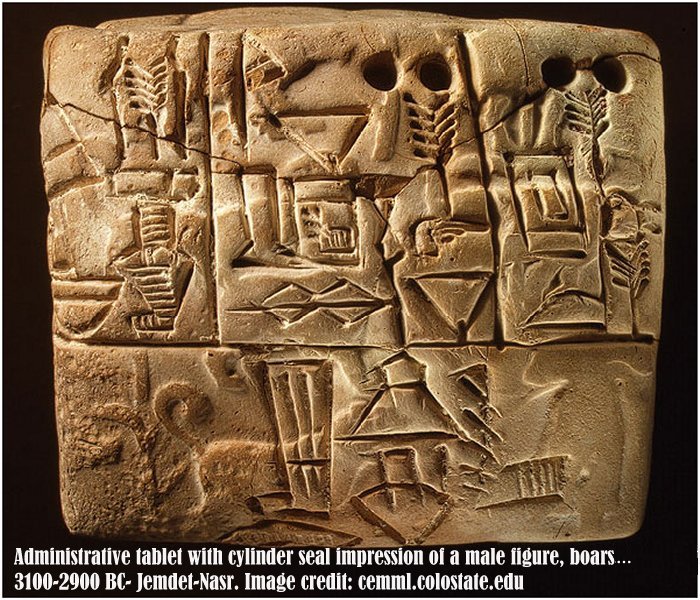Mesopotamian City Jemdet Nasr Dated To 3100–2900 BC: Sophisticated Irrigation Techniques And Earliest Cylinder Seals
A. Sutherland - AncientPages.com - Jemdet Nasr - related to the Jemdet Nasr period (3100–2900 BC) - was a small but important prehistoric settlement in southern Mesopotamia, what is today, Babil located south of Baghdad, between the Euphrates and Tigris Rivers, Iraq.
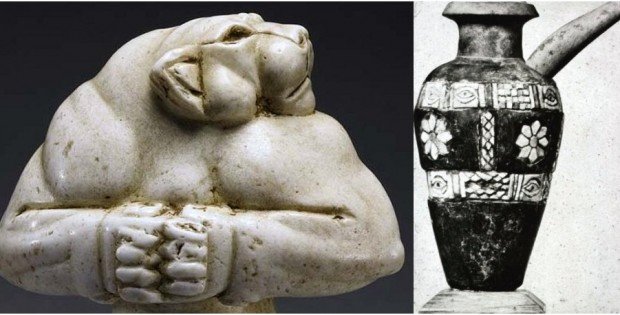
Left: Amazing Lioness-Woman Figurine dated stylistically to the Jemdet-Nasr period. (Sothebys New York; Right: Jemdet-Nasr pottery. Image:http://classics.unc.edu/
Excavations conducted in 1926 and 1928 revealed a large structure (92 × 48 m) constructed of both sun-dried and baked mud bricks, with clay roofing and ceramic gutters or drains. It had narrow rooms on three sides of a more open area, all resting on a brick platform. Additionally, more than two hundred inscribed clay tablets were found within the building.
The tablets and further excavations confirmed that ancient Jemdet Nasr was occupied during several periods, such as Ubaid (ca. 6500 to 3800 BC), Uruk (ca. 4000 to 3100 BC), and Early Dynastic (2900–2350 BC).
Jemdet Nasr ("Small mound of Nasr") experienced breakthroughs in the development of art, urban culture, writing, trade, and irrigation technology, which increased its importance. During this period numerous small Mesopotamian settlements developed into major cities, and the earliest cylinder seals came into use in southern Mesopotamia.
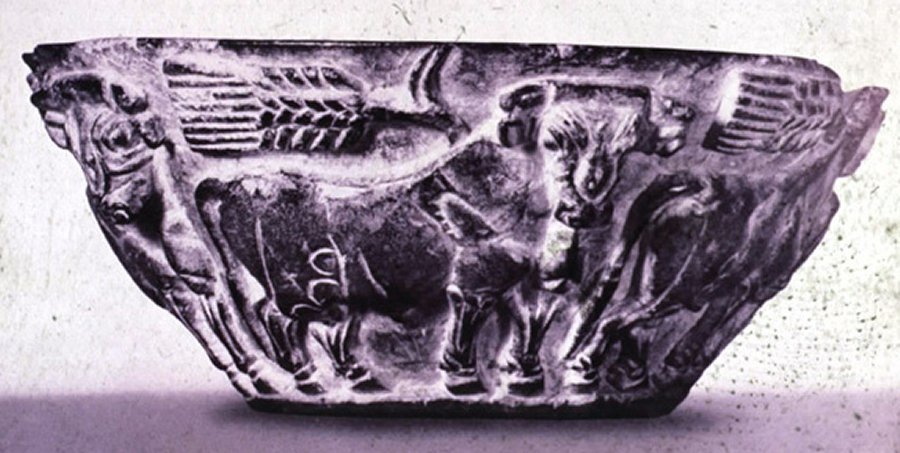
Steatite bowl with bulls in relief (5 cm. high). Found in a house of much later (Persian) times; dated stylistically to the Jemdet-Nasr period. Image credits: classics.unc.edu/
Pottery and cylinder seal impressions
The main features of the Jemdet Nasr are copper objects and pottery (large jars, bowls, spouted vessels, and cups), usually painted black and red geometric patterns. Other pottery forms found at the site include painted pots depicting both geometric motifs and depictions of animals, including birds, fish, goats, scorpions, snakes, and trees.
The pottery and cylinder seals clearly mark the difference between the Jemdet Nasr period (circa 3100-2900 BC) Jemdet Nasr and the proceeding Uruk period.
The cuneiform tablets, second in age only to those discovered at Uruk, mostly deal with agricultural administration, and some are covered with seal impressions, of which one – the so-called “City Seal“ impression, contains symbols for many neighboring cities including Ur, Nippur, Zabalam, Larsa and Kesh, and accompanying inscriptions which suggest these cities were some kind of a league, possibly engaged in sending offerings to Uruk.
The Jemdet Nasr period represents the final stage before the Sumerian Early Dynastic Period began in southern Mesopotamia.
No evidence for far-reaching trade contacts, exotic goods or precious stones were found, but Jemdet Nasr must have had intensive regional contacts with several cities in southern Mesopotamia, including Larsa, Nippur, Ur, Uruk, and Tell Uqair. Power was concentrated in the hands of kings-priests and religion played an important role in the social life of the city. During the Jemdet Nasr period increased the number of cities, temples, and buildings.
Sophisticated irrigation techniques were used for growing plants, which was very important due to inadequate rainfall.
The production of bronze, an alloy of copper and other metals, mainly tin, allowed the production of new weapons, and fortifications around the villages and city walls were built for better protection.
Written by – A. Sutherland AncientPages.com Senior Staff Writer
Copyright © AncientPages.com All rights reserved. This material may not be published, broadcast, rewritten or redistributed in whole or part without the express written permission of AncientPages.com
Expand for referencesMore From Ancient Pages
-
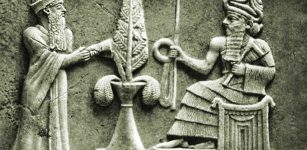 Mighty Enlil Of The Sumerian Pantheon Of Gods
Featured Stories | Feb 22, 2017
Mighty Enlil Of The Sumerian Pantheon Of Gods
Featured Stories | Feb 22, 2017 -
 Stunning Discovery Of 1,000-Year-Old Knight’s Sword From Reign Of Poland’s First King Bolesław The Brave
Archaeology | Jul 28, 2022
Stunning Discovery Of 1,000-Year-Old Knight’s Sword From Reign Of Poland’s First King Bolesław The Brave
Archaeology | Jul 28, 2022 -
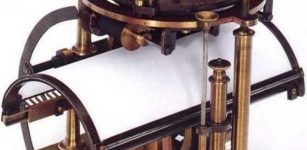 The Writing Ball: A Great Invention In 1870
Ancient History Facts | Jun 30, 2016
The Writing Ball: A Great Invention In 1870
Ancient History Facts | Jun 30, 2016 -
 Those Who Mysteriously Disappeared To A World Beyond Human Understanding
Featured Stories | Apr 30, 2019
Those Who Mysteriously Disappeared To A World Beyond Human Understanding
Featured Stories | Apr 30, 2019 -
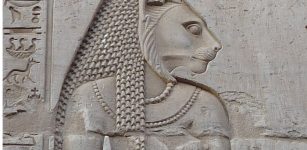 Fearsome Sekhmet: Lion-Headed Egyptian Goddess And Sister Of Ptah
Egyptian Mythology | May 13, 2020
Fearsome Sekhmet: Lion-Headed Egyptian Goddess And Sister Of Ptah
Egyptian Mythology | May 13, 2020 -
 Eleanor Of Aquitaine – Mother Of King Richard The Lionheart And One Of Most Powerful Women Of Middle Ages
Featured Stories | Feb 26, 2018
Eleanor Of Aquitaine – Mother Of King Richard The Lionheart And One Of Most Powerful Women Of Middle Ages
Featured Stories | Feb 26, 2018 -
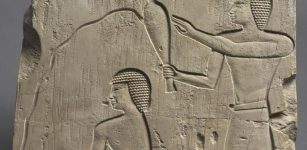 Daily Life Of Priests And Priestesses In Ancient Egypt
Ancient History Facts | Apr 5, 2018
Daily Life Of Priests And Priestesses In Ancient Egypt
Ancient History Facts | Apr 5, 2018 -
 Mysterious Yamacutah – A Sacred Native American Indian Shrine
Artifacts | Sep 18, 2020
Mysterious Yamacutah – A Sacred Native American Indian Shrine
Artifacts | Sep 18, 2020 -
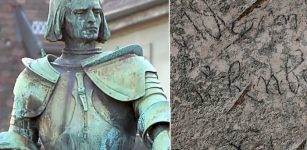 A Graffiti Inscription With The Name Of Knight Adrian von Bubenberg – Found On Mount Zion In Jerusalem
Archaeology | Nov 30, 2022
A Graffiti Inscription With The Name Of Knight Adrian von Bubenberg – Found On Mount Zion In Jerusalem
Archaeology | Nov 30, 2022 -
 Antediluvian Artifact Discovered In Egyptian Tomb May Solve The Great Pyramid Mystery?
Featured Stories | May 3, 2018
Antediluvian Artifact Discovered In Egyptian Tomb May Solve The Great Pyramid Mystery?
Featured Stories | May 3, 2018 -
 2,000-Year-Old Teeth Reveal The Diet Of An Iron Age Woman
Archaeology | Oct 26, 2022
2,000-Year-Old Teeth Reveal The Diet Of An Iron Age Woman
Archaeology | Oct 26, 2022 -
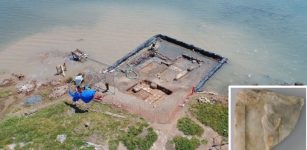 Ancient Greek Seven-Room Building And Treasures Found Underwater Off The Coast Of Salamis
Archaeology | Nov 1, 2023
Ancient Greek Seven-Room Building And Treasures Found Underwater Off The Coast Of Salamis
Archaeology | Nov 1, 2023 -
 Invisible Ink On Antique Nile Papyrus From The Island Of Elephantine – Revealed
Archaeology | Aug 21, 2019
Invisible Ink On Antique Nile Papyrus From The Island Of Elephantine – Revealed
Archaeology | Aug 21, 2019 -
 The Day When The Sun Did Not Come Out – Bizarre Event In 1780, New England
Featured Stories | Apr 18, 2023
The Day When The Sun Did Not Come Out – Bizarre Event In 1780, New England
Featured Stories | Apr 18, 2023 -
 Code Of Chivalry: ‘Knightly’ Behavior, Courageous Medieval Knights, Warriors And Superior Men
Featured Stories | Jun 5, 2016
Code Of Chivalry: ‘Knightly’ Behavior, Courageous Medieval Knights, Warriors And Superior Men
Featured Stories | Jun 5, 2016 -
 A Glimpse Into The Past – Sights And Sounds Of St. Paul’s Cathedral Recreated
Archaeology | Oct 8, 2021
A Glimpse Into The Past – Sights And Sounds Of St. Paul’s Cathedral Recreated
Archaeology | Oct 8, 2021 -
 Hopi Ancestors Witnessed Flying Shields In The Skies Over Palitkwapi – The ‘Red City’
Civilizations | Apr 8, 2017
Hopi Ancestors Witnessed Flying Shields In The Skies Over Palitkwapi – The ‘Red City’
Civilizations | Apr 8, 2017 -
 Change Of Burial Tradition Among The People of Early Medieval Europe
Archaeology | Aug 6, 2021
Change Of Burial Tradition Among The People of Early Medieval Europe
Archaeology | Aug 6, 2021 -
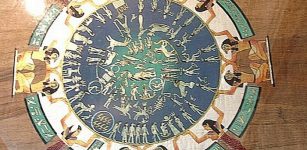 Ancient Papyrus Reveals Millennia Old Astronomical Secret: The ‘Demon Star’ Algol Does Exist
Civilizations | Aug 23, 2015
Ancient Papyrus Reveals Millennia Old Astronomical Secret: The ‘Demon Star’ Algol Does Exist
Civilizations | Aug 23, 2015 -
 Paracelsus: Physician, Alchemist, Philosopher Well Ahead Of His Time
Featured Stories | Apr 28, 2016
Paracelsus: Physician, Alchemist, Philosopher Well Ahead Of His Time
Featured Stories | Apr 28, 2016

